Fully Functional Miniature Weapon Models Crafted with Exceptional Quality and a Lifetime Service Guarantee
Weapons and Historical Figures of the 20th Century. Part I: The Bad Guys
Table of Contents
Do evil leaders share a common reason for choosing golden guns, such as a unified field theory for men with twisted moral principles who coat their weapons in 24-karat gold?
Adolf Hitler, Muammar Gaddafi, and Saddam Hussein were violent rulers who maintained power through the use of guns and terror, as emphasized by Mao’s statement that “Political power grows out of the barrel of a gun.”
A more direct explanation is that it could simply be a matter of bad taste. When you live in a bubble, isolated from individuals who are unwilling to critically assess your ideas and opinions due to fear of potential repercussions such as imprisonment or torture, your perspectives can become distorted.
In that bubble, ruling a state built on violence, surrounded by yes-men, power, and money, gold-plated guns start to look pretty appealing. Nobody will tell you they aren’t if it’s your idea.
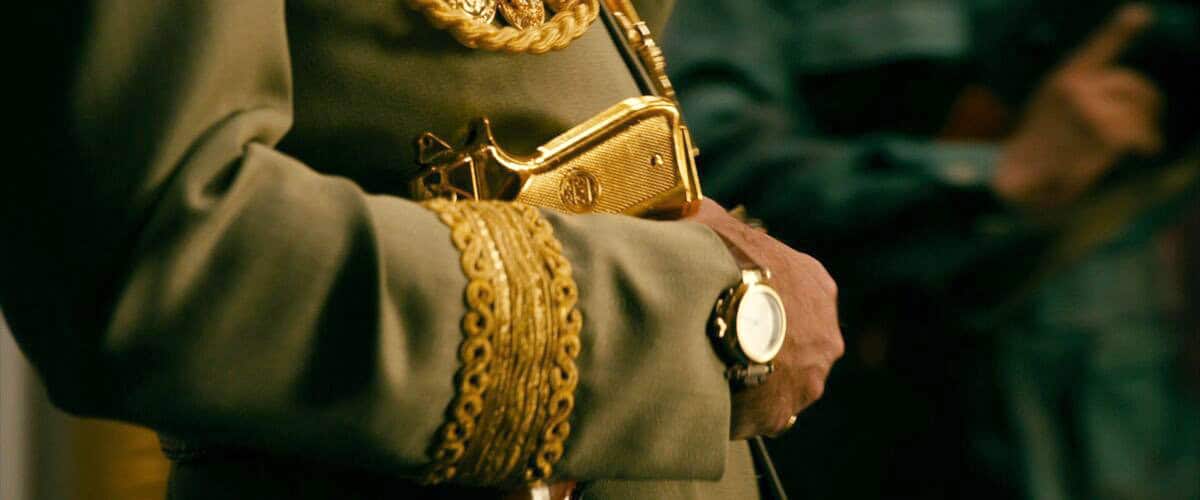
Stalin & Makarov Pistol
Joseph Stalin had an American Winchester and a Belgian Browning in his considerable arsenal. However, the most famous weapon of the “leader of the nations” was the Tula Mosin rifle. It is from this rifle that, in the documentary footage of 1934, he aims at a hall full of deputies of the 17th Congress of the Communist Party.
The Mosin rifle was presented to the Soviet dictator by Tula gunsmiths, and he immediately tested the sniper scope’s accuracy by pointing the gun barrel directly into the hall. Stalin did not intend to shoot then, but he apparently aimed for a reason: almost two-thirds of the 139 party members were shot shortly after the leader’s ominous gesture – during the years of the Great Terror. It is no coincidence that in history, this congress received the name “Congress of the Executed.”
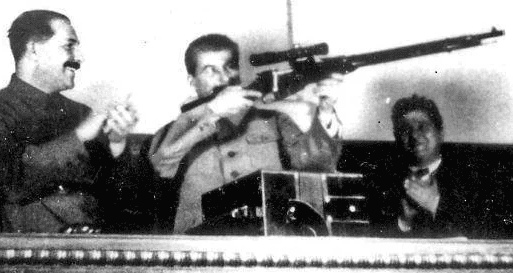
Stalin’s arsenal also included six “Walters”, two Mausers, and two revolvers. He also had a pair of Brownings in his inventory – a tribute to his youth. Biographers describe that at the dawn of his revolutionary youth, Joseph Dzhugashvili was engaged in robberies and assaults, often using a Belgian Browning as an argument – small, invisible in the pocket, and having good accuracy.
Researchers note that a feature of the weapons collection of the “leader of the peoples” was the absence of nameplates, gilding, inlays, etc. But all Stalin’s jackets had a secret, specially sewn pocket with a metal ring and a chain. When leaving the territory of the residence, the leader always took a loaded pistol with him, attaching it to this ring. Returning home, Stalin usually put the weapons in the sideboard drawer.
In 1949, to commemorate his 70th birthday, Joseph Stalin was presented with a Makarov 9x18mm semi-automatic pistol designed by Nikolay Makarov. The government then selected this pistol for further development and mass production the same year. By 1951, the Makarov pistol had become the standard issue sidearm for the military and police forces of the Soviet Union. This gift came from gunsmiths in Tula, a city in the south of Moscow. The words “To Joseph Vissarionovich Stalin, for 70th Birthday, from Tula Gunmakers” were delicately engraved on the barrel of the pistol.
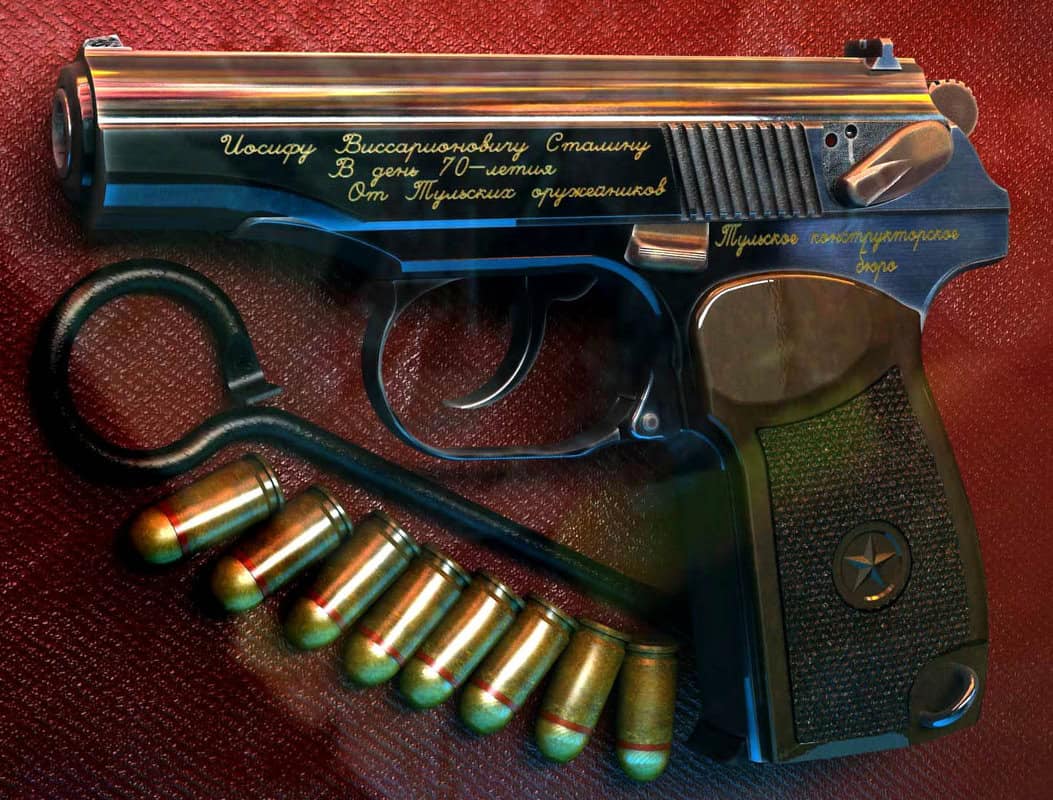
Chiang Kai-shek & Mauser K98
In the tumultuous era of early 20th century China, amidst warlords and shifting alliances, a unique firearm emerged as a symbol of military prowess and national identity—the Type Chiang Kai-shek rifle, also known as the Generalissimo rifle. Named in honor of the Chinese leader Chiang Kai-shek, this rifle was more than just a weapon; it represented a fusion of international influence and domestic production.
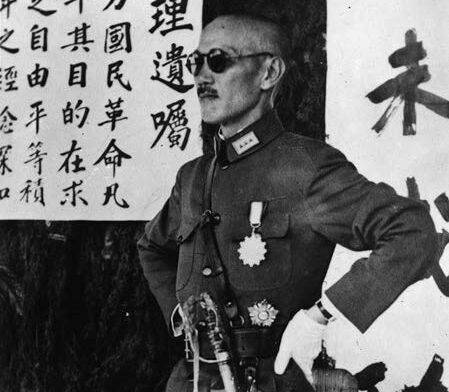
The origins of the Type Chiang Kai-shek rifle trace back to Germany’s Standardmodell rifle, the precursor to the iconic Karabiner 98k. Manufactured in China starting in 1935, which corresponded to the year 24 in the Republican calendar, it was designated as the Type 24. Interestingly, the Chinese Communists referred to it as the Type 79.
This rifle was not merely a copy but a product of collaboration, with the Germans providing tooling and expertise for its production.
Early production began in earnest just before the outbreak of the Second Sino-Japanese War, though full standardization occurred during the conflict. Despite its intended use by the National Revolutionary Army, led by Chiang Kai-shek, the rifle found itself in the hands of both Nationalists and Communists alike during the turbulent Chinese Civil War. Its robust design and reliability made it a staple in the hands of Chinese soldiers, alongside iconic weapons like the Mauser C96 handgun and the M35 Helmet.
As history unfolded, the Type Chiang Kai-shek rifle gradually gave way to more advanced American weaponry supplied to the Nationalists, such as the M1 Garand and Thompson submachine gun, by the end of the 1940s. Despite being phased out from frontline service, it continued to serve in reserve capacities well into the 1970s, testament to its durability and utility in the field.
Interestingly, even after its military retirement, the Type Zhongzheng rifle (as it was also known) persisted as a ceremonial and parade rifle within the Republic of China’s armed forces, alongside the revered M1 Garand. It was a nod to its historical significance and the enduring legacy of its namesake, Generalissimo Chiang Kai-shek.
Beyond its military role, these rifles saw varied use throughout Chinese history, from the Korean War with the People’s Volunteer Army to the Cultural Revolution, where they found themselves in the hands of various factions and militias.
Today, the Type Chiang Kai-shek rifle stands as a symbol of China’s turbulent past and the resilience of its armed forces. From the battlefields of the early 20th century to ceremonial duties in the modern era, it remains a testament to the evolving nature of warfare and the enduring legacy of its namesake.
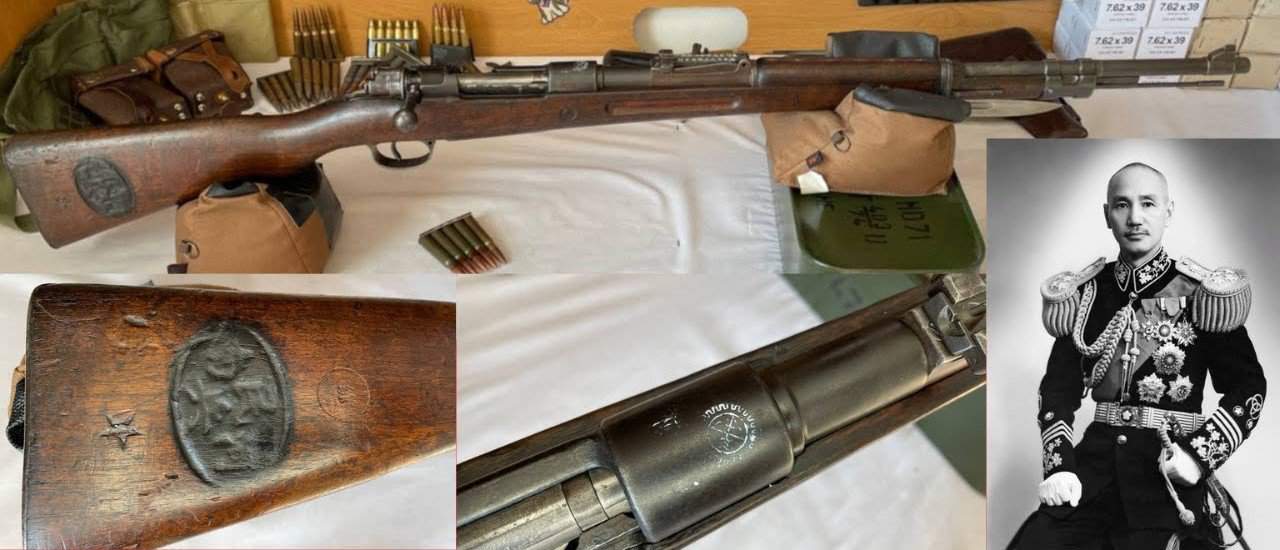
Adolf Hitler & Golden Walther PPK
n his 50th birthday in 1939, Adolf Hitler received a specially engraved 7.65 mm Walther PP pistol from Carl Walther, the renowned German gunsmith. Adorned with intricate engravings and featuring Hitler’s initials “AH” on its ivory grips, this gift symbolized the close relationship between the dictator and the Walther family, known for their firearms widely used by the German military.
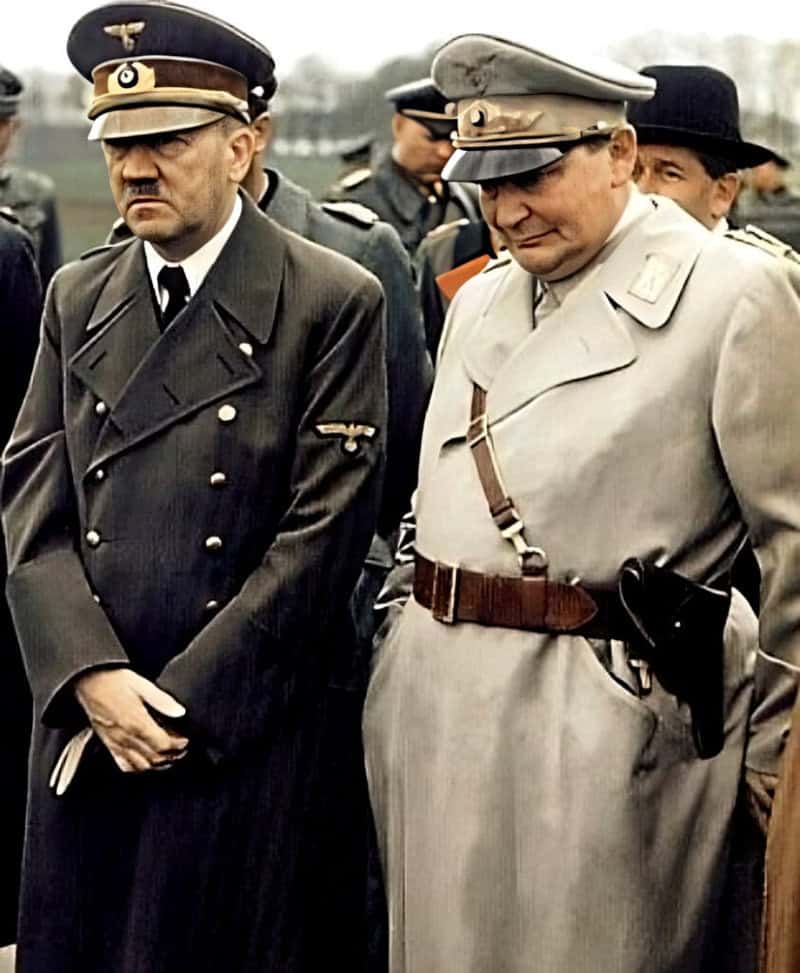
The extravagant celebrations on April 20, 1939, marked Hitler’s birthday, where the Nazi Party presented him with a multitude of gifts, including the gold-plated pistol. Amidst military parades and aerial displays, Hitler cherished the pistol, eventually keeping it in his Munich apartment.
The pistol’s journey took a dramatic turn in April 1945 when US Army soldier Ira “Teen” Palm discovered it in Hitler’s abandoned office in Munich. Palm, part of a mission to capture Hitler, retrieved the pistol, which he later gave to his friend Charles Woodbridge, a pastor in Savannah, Georgia. However, the pistol was stolen in a burglary in 1947 from the Woodbridge home.
Resurfacing in the 1950s at a gun show in Wichita, Kansas, the pistol gained notoriety through photographs and media coverage. Eventually purchased by Canadian collector Andrew Wright, it became part of a museum display until its auction in 1987, fetching a record $114,000. Subsequently, it passed through various hands, including those of Warren Anderson in Australia and later a dealer in Georgia.
The pistol’s history took a macabre twist when blood was reportedly discovered under its grips during an inspection in Cleveland in 1966. Speculation arose whether the blood belonged to Palm himself, the soldier who first seized the pistol from Hitler’s office.
Today, the current whereabouts of this historic artifact remain uncertain, adding to its mystique and the enduring fascination with one of World War II’s most infamous relics.
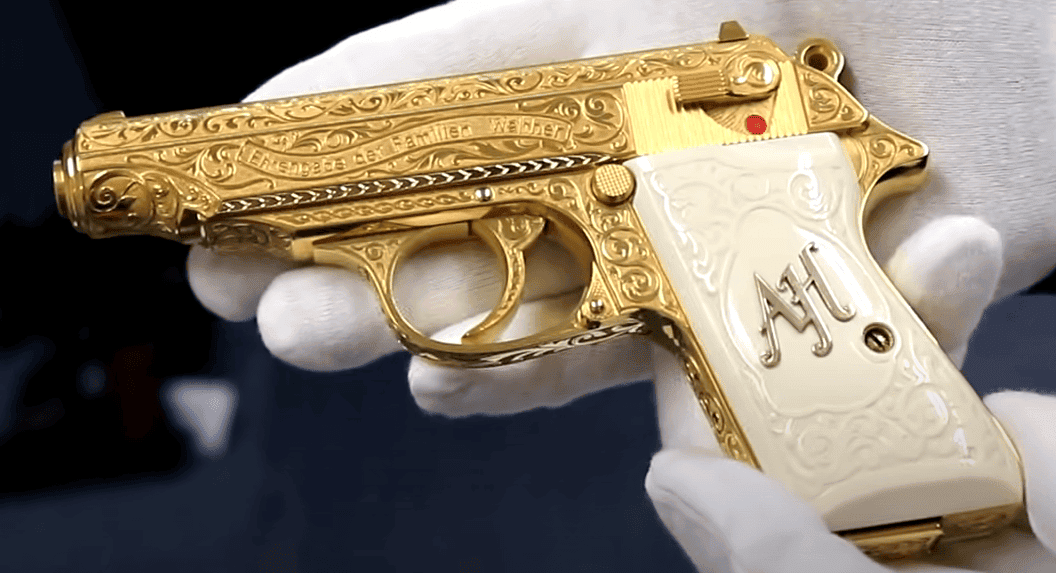
Fidel Castro & Golden Colt 1911
Fidel Castro’s golden Colt 1911 pistol is a fascinating piece of Cold War history, steeped in intrigue and symbolism. The story begins in the early 1960s, amidst the tense relations between the United States and Cuba, shortly after Castro had consolidated power following the Cuban Revolution of 1959.
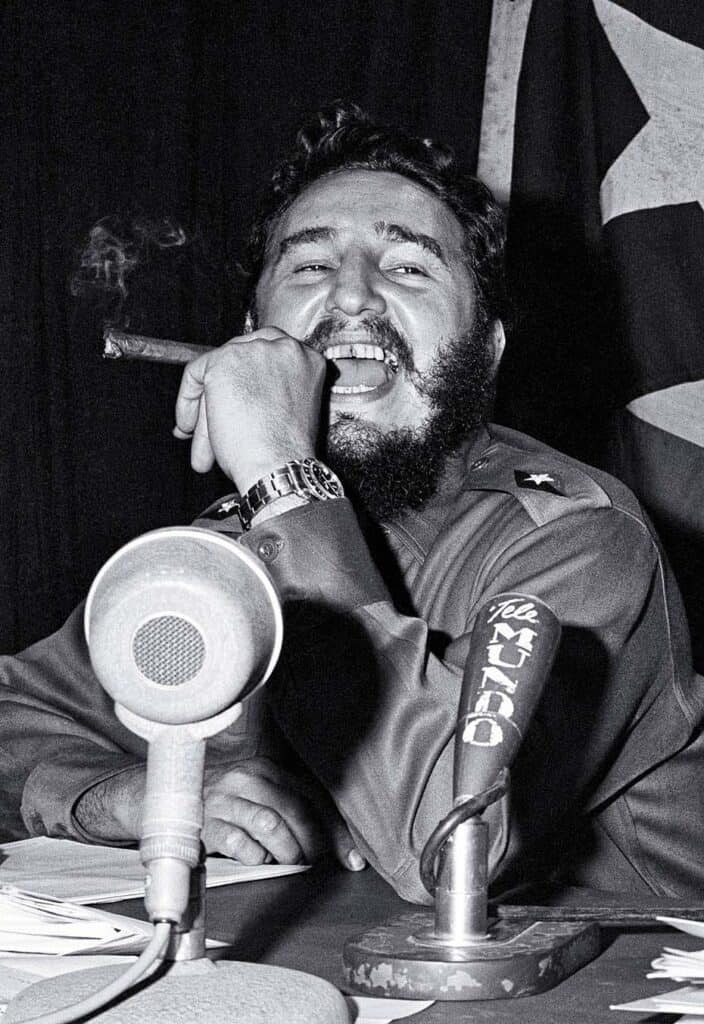
The Colt 1911 pistol, a highly esteemed firearm known for its robustness and iconic status, was rumored to have been a personal gift to Castro from a Colombian guerrilla leader, possibly in recognition of Castro’s revolutionary efforts and anti-imperialist stance. The exact details of how Castro came into possession of the pistol remain somewhat mysterious and shrouded in speculation, adding to its mystique.
What sets this particular Colt 1911 apart is its customization: it was reportedly coated in gold and adorned with intricate engravings. This transformation elevated the pistol from a mere weapon to a symbol of power and defiance against perceived Western imperialism, which Castro vehemently opposed throughout his rule.
Castro, known for his charismatic leadership and fierce commitment to socialism and Cuban nationalism, often used symbolic gestures and artifacts to reinforce his revolutionary credentials. The golden Colt 1911 pistol became one such symbol, representing both the revolutionary spirit of Cuba and Castro’s personal defiance against his ideological adversaries.
The pistol’s historical significance was not just in its material form but also in the narrative it helped shape. It became a focal point of discussions and stories surrounding Castro’s persona and Cuba’s revolutionary struggle against U.S. influence in Latin America.
In the decades following its emergence into public consciousness, the golden Colt 1911 pistol has remained a notable artifact of the Cold War era, a tangible reminder of the ideological battles and geopolitical tensions that defined that period.
Today, the exact whereabouts of Castro’s golden Colt 1911 pistol are uncertain. It is often cited in discussions about historical artifacts and the legacy of Fidel Castro, serving as a reminder of a bygone era when ideologies clashed and symbols held significant meaning on the world stage.
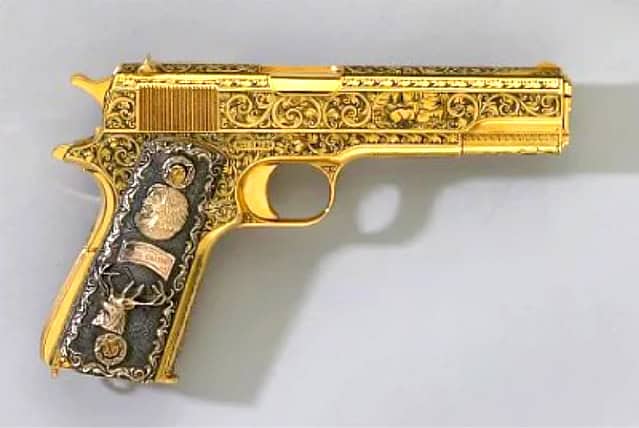
Saddam Hussein & Golden AK-47
Saddam Hussein’s golden AK-47 holds a unique place in the annals of military history. Custom-made for the Iraqi dictator, this rifle symbolized his authoritarian rule and penchant for opulence amid conflict.
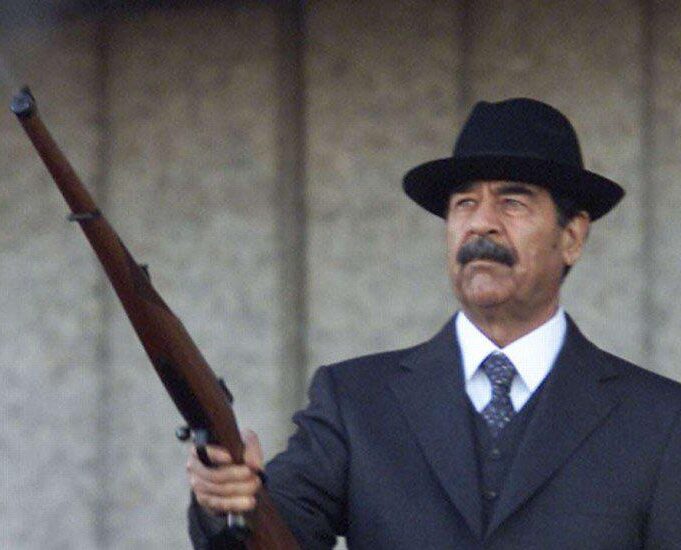
The AK-47 itself is an iconic weapon, known for its reliability and widespread use worldwide. Saddam’s version was reportedly plated in gold and embellished with engravings, reflecting his desire to project power and prestige.
The rifle was often displayed during Hussein’s public appearances, serving both as a tool of intimidation and a symbol of his leadership. It became a visual representation of his regime’s military prowess and his personal image as a strongman.
Following Saddam Hussein’s downfall in 2003, the golden AK-47 became a sought-after item among collectors and historians, encapsulating a turbulent era in Iraqi and Middle Eastern history.
Today, the exact location and ownership of Saddam Hussein’s golden AK-47 remain unclear, adding to its mystique and the fascination surrounding this unique piece of weaponry associated with one of the 20th century’s most controversial leaders.
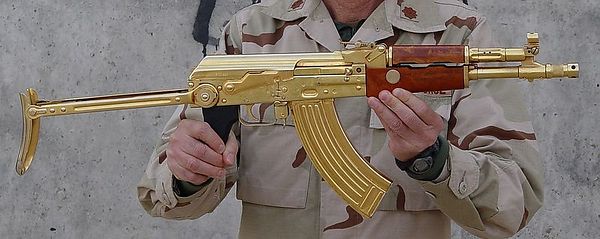
Muammar Gaddafi & Golden Browning Hi-Power
Muammar Gaddafi’s golden Browning Hi-Power pistol is a striking symbol of his flamboyant leadership and controversial reign over Libya. Custom-made and adorned with gold plating and intricate engravings, the pistol exemplified Gaddafi’s eccentric taste and desire for ostentation.
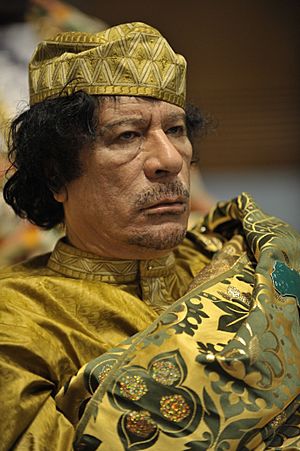
The Browning Hi-Power itself is a renowned firearm, valued for its reliability and use by military and law enforcement worldwide. Gaddafi’s personalized version not only served as a functional weapon but also as a statement piece, often displayed during his public appearances and speeches.
As Libya’s leader for over four decades, Gaddafi utilized symbols like his golden pistol to cultivate a cult of personality and project an image of strength and authority. The pistol became synonymous with his regime’s grip on power and his larger-than-life persona.
After Gaddafi’s overthrow and death in 2011, his golden Browning Hi-Power pistol became a sought-after artifact, embodying the excesses and contradictions of his rule. Its whereabouts today are uncertain, adding to the intrigue and legacy of Muammar Gaddafi in modern history.
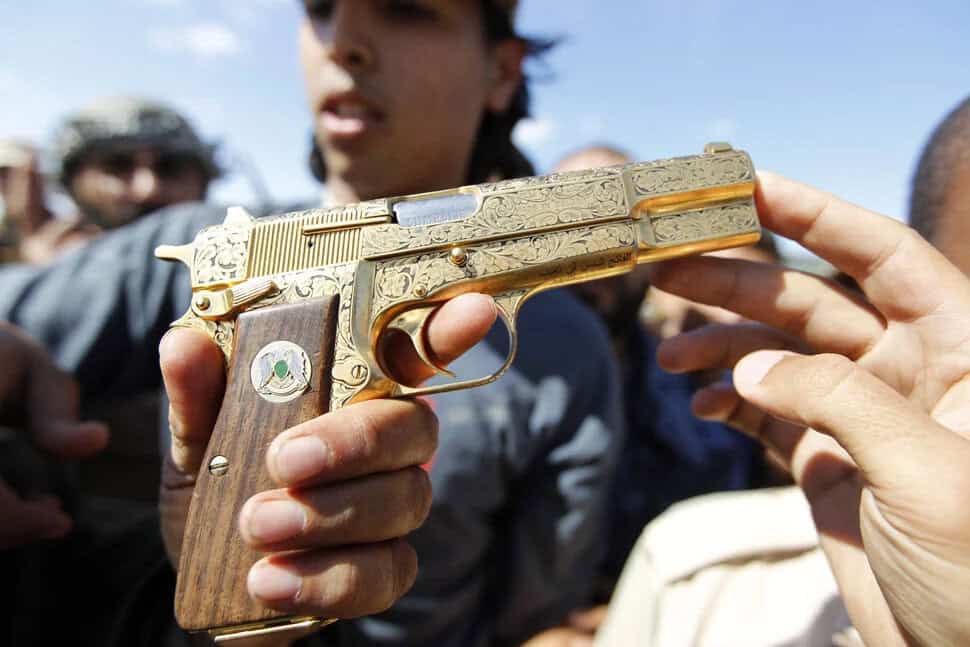
Perhaps no unified theory explains why evil men are drawn to gold guns. Those who are unstable enough to intertwine violence with their pursuit of power are, by definition, different from the majority of us. It’s already difficult to comprehend someone’s reasons for committing murder; could we possibly understand why they have an affinity for lethal and gaudy objects?
In conclusion, gold-plated firearms owned by infamous 20th-century dictators symbolize not just power but also their personal vanity and isolated lifestyles. These ornate weapons reflect the distorted sense of taste and luxury of these leaders, highlighting their attempt to showcase power through opulence and providing a psychological portrait of these historical figures.
About the Author
My name is Olha Polah, and I have been working in miniature weapons production since 2015. I started the mini firearms brand and have been running the brand’s Instagram page since 2016. The brand’s miniatures are popular worldwide, with fans in 25+ countries. I became the sole owner of the brand in 2018 and created a comprehensive line of miniatures. More than 60 models of miniature weapons from various historical periods have been created. In November 2023, I was interviewed by Robert Dunn for the GunTech magazine, where I talked about the hardships I had to endure in my business. I also run a newsletter for the brand’s customers, which has evolved into a full-fledged magazine with in-depth articles published on the wpolah.com.

My mission is to make people’s lives more joyful by sharing interesting facts about miniature weapons and inspiring everyone to express themselves.
